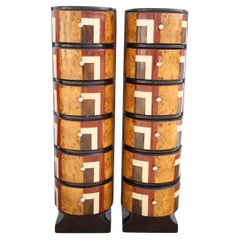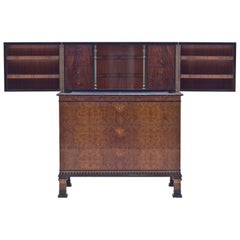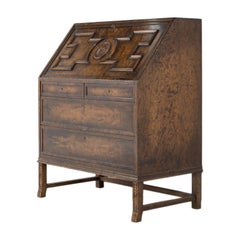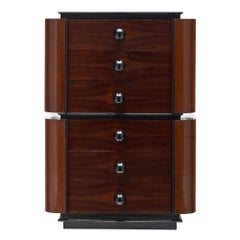Chiffonier Art Deco
Late 20th Century American Art Deco Dressers
Wood, Lacquer
Vintage 1930s Swedish Art Deco Commodes and Chests of Drawers
Felt, Elm, Rosewood
Recent Sales
Vintage 1920s Swedish Art Deco Dressers
Birch
Vintage 1940s French Art Deco Commodes and Chests of Drawers
Murano Glass, Rosewood
Vintage 1930s French Art Deco Commodes and Chests of Drawers
Brass
Vintage 1930s French Art Deco Commodes and Chests of Drawers
Metal, Stainless Steel
Vintage 1930s English Art Deco Linen Presses
Oak, Rosewood
20th Century Secretaires
Rosewood
Vintage 1940s French Art Deco Commodes and Chests of Drawers
Vintage 1930s French Cabinets
Bubinga
Late 20th Century Art Deco Cabinets
People Also Browsed
Mid-20th Century German Mid-Century Modern Flush Mount
Metal
2010s Canadian Modern Chandeliers and Pendants
Brass
2010s Italian Modern Credenzas
Marble, Gold, Brass
Vintage 1940s Italian Art Deco Tables
Maple
Early 20th Century French Art Deco Club Chairs
Linen, Upholstery, Beech, Fabric
Antique Early 19th Century Swedish Gustavian Secretaires
Brass
21st Century and Contemporary Industrial Wall Lights and Sconces
Brass
Vintage 1930s Swedish Art Deco Commodes and Chests of Drawers
Ash
Vintage 1960s Finnish Scandinavian Modern Chandeliers and Pendants
Brass
Antique 19th Century Chinese Beds and Bed Frames
Gold Leaf
Vintage 1960s Dining Room Tables
Marble
Vintage 1970s American Chinese Chippendale Benches
Wood, Faux Bamboo
Antique Mid-19th Century French Prints
Wood, Paper
Antique 1890s French Art Nouveau Vases
Art Glass
Vintage 1960s Canadian Mid-Century Modern Night Stands
Brass
Vintage 1940s Italian Art Deco Commodes and Chests of Drawers
Brass
Chiffonier Art Deco For Sale on 1stDibs
How Much is a Chiffonier Art Deco?
A Close Look at Art Deco Furniture
Art Deco furniture is characterized by its celebration of modern life. More than its emphasis on natural wood grains and focus on traditional craftsmanship, vintage Art Deco dining chairs, tables, desks, cabinets and other furniture — which typically refers to pieces produced during the 1920s and 1930s — is an ode to the glamour of the “Roaring Twenties.”
ORIGINS OF ART DECO FURNITURE DESIGN
- Emerged in the 1920s
- Flourished while the popularity of Art Nouveau declined
- Term derives from 1925’s Exposition Internationale des Arts Décoratifs et Industriels Modernes (International Exhibition of Modern Decorative and Industrial Arts) in Paris, France
- Informed by Ancient Egypt, Cubism, Futurism, Louis XVI, De Stijl, modernism and the Vienna Secession; influenced Streamline Moderne and mid-century modernism
CHARACTERISTICS OF ART DECO FURNITURE DESIGN
- Bold geometric lines and forms, floral motifs
- Use of expensive materials such as shagreen or marble as well as exotic woods such as mahogany, ebony and zebra wood
- Metal accents, shimmering mirrored finishes
- Embellishments made from exotic animal hides, inlays of mother-of-pearl or ivory
ART DECO FURNITURE DESIGNERS TO KNOW
VINTAGE ART DECO FURNITURE ON 1STDIBS
Few design styles are as universally recognized and appreciated as Art Deco. The term alone conjures visions of the Roaring Twenties, Machine Age metropolises, vast ocean liners, sleek typography and Prohibition-era hedonism. The iconic movement made an indelible mark on all fields of design throughout the 1920s and ’30s, celebrating society’s growing industrialization with refined elegance and stunning craftsmanship.
Widely known designers associated with the Art Deco style include Émile-Jacques Ruhlmann, Eileen Gray, Maurice Dufrêne, Paul Follot and Jules Leleu.
The term Art Deco derives from the name of a large decorative arts exhibition held in Paris in 1925. “Art Deco design” is often used broadly, to describe the work of creators in associated or ancillary styles. This is particularly true of American Art Deco, which is also called Streamline Moderne or Machine Age design. (Streamline Moderne, sometimes known as Art Moderne, was a phenomenon largely of the 1930s, post–Art Nouveau.)
Art Deco textile designers employed dazzling floral motifs and vivid colors, and while Art Deco furniture makers respected the dark woods and modern metals with which they worked, they frequently incorporated decorative embellishments such as exotic animal hides as well as veneers in their seating, case pieces, living room sets and bedroom furniture.
From mother-of-pearl inlaid vitrines to chrome aviator chairs, bold and inventive works in the Art Deco style include chaise longues (also known as chaise lounges) and curved armchairs. Today, the style is still favored by interior designers looking to infuse a home with an air of luxury and sophistication.
The vintage Art Deco furniture for sale on 1stDibs includes dressers, coffee tables, decorative objects and more.
Finding the Right Case Pieces And Storage Cabinets for You
Of all the vintage storage cabinets and antique case pieces that have become popular in modern interiors over the years, dressers, credenzas and cabinets have long been home staples, perfect for routine storage or protection of personal items.
In the mid-19th century, cabinetmakers would mimic styles originating in the Louis XIV, Louis XV and Louis XVI eras for their dressers, bookshelves and other structures, and, later, simpler, streamlined wood designs allowed these “case pieces” or “case goods” — any furnishing that is unupholstered and has some semblance of a storage component — to blend into the background of any interior.
Mid-century modern furniture enthusiasts will cite the tall modular wall units crafted in teak and other sought-after woods of the era by the likes of George Nelson, Poul Cadovius and Finn Juhl. For these highly customizable furnishings, designers of the day delivered an alternative to big, heavy bookcases by considering the use of space — and, in particular, walls — in new and innovative ways. Mid-century modern credenzas, which, long and low, evolved from tables that were built as early as the 14th century in Italy, typically have no legs or very short legs and have grown in popularity as an alluring storage option over time.
Although the name immediately invokes images of clothing, dressers were initially created in Europe for a much different purpose. This furnishing was initially a flat-surfaced, low-profile side table equipped with a few drawers — a common fixture used to dress and prepare meats in English kitchens throughout the Tudor period. The drawers served as perfect utensil storage. It wasn’t until the design made its way to North America that it became enlarged and equipped with enough space to hold clothing and cosmetics. The very history of case pieces is a testament to their versatility and well-earned place in any room.
In the spirit of positioning your case goods center stage, decluttering can now be design-minded.
A contemporary case piece with open shelving and painted wood details can prove functional as a storage unit as easily as it can a room divider. Alternatively, apothecary cabinets are charming case goods similar in size to early dressers or commodes but with uniquely sized shelving and (often numerous) drawers.
Whether you’re seeking a playful sideboard that features colored glass and metal details, an antique Italian hand-carved storage cabinet or a glass-door vitrine to store and show off your collectibles, there are options for you on 1stDibs.
- What is an art deco watch?1 Answer1stDibs ExpertApril 5, 2022An art deco watch is defined by its geometric case, which is either circular or rectangular. The watch style was highly popular between 1920 and 1950, and is still sought after today. You’ll find a collection of art deco watches from some of the world’s top sellers on 1stDibs
- What is art deco jewelry?1 Answer1stDibs ExpertFebruary 22, 2021Art Deco jewelry was popular during the design movement of the 1920s and 30s. Art Deco jewelry is typically characterized by geometric patterns and gemstones of contrasting colors.
- What was the Art Deco movement?1 Answer1stDibs ExpertMay 30, 2024The Art Deco movement was a decorative style popular during the 1920s and ’30s. Few design styles are as universally recognized and appreciated as Art Deco. The term alone conjures visions of the Roaring Twenties, Machine Age metropolises, vast ocean liners, sleek typography and Prohibition-era hedonism. The iconic movement made an indelible mark on all fields of design, celebrating society's growing industrialization with refined elegance and stunning craftsmanship. Widely known designers associated with the Art Deco style include Émile-Jacques Ruhlmann, Eileen Gray, Maurice Dufrêne, Paul Follot and Jules Leleu. The term Art Deco derives from the name of a large decorative arts exhibition held in Paris in 1925. On 1stDibs, shop a wide range of Art Deco furniture and decorative objects.
- What is the history of Art Deco?1 Answer1stDibs ExpertMarch 25, 2024The history of Art Deco begins in the early 20th century.
Art Deco emerged as a global design style around the start of World War I, during the last years of Art Nouveau's popularity. The style conjures visions of the Roaring Twenties, Machine Age metropolises, vast ocean liners, sleek typography and Prohibition-era hedonism. Its hallmarks include the use of geometric designs influenced by Cubism. Major discoveries of Egyptian tombs during the era also influenced the movement.
The term Art Deco derives from the name of a large decorative arts exhibition, the Exposition Internationale des Arts Décoratifs et Industriels Modernes, held in Paris in 1925. After World War II, tastes shifted toward more functional, less ornate modernism, but today, the Art Deco style is still favored for its luxurious sophistication. On 1stDibs, shop a large selection of vintage Art Deco furniture. - How do I identify Art Deco?1 Answer1stDibs ExpertApril 5, 2022To identify Art Deco, look for the characteristics of the period. Furniture produced at the time is generally lacquered metal with a mirror-like glossy finish. Wooden items should be an exotic wood. Most items feature symmetrical designs, and geometric forms were popular motifs during the period. In addition, Art Deco often shows the influence of Hellenistic, Egyptian and Asian designs. Shop a variety of Art Deco furniture and decorative objects on 1stDibs.
- When did Art Deco originate?1 Answer1stDibs ExpertFebruary 1, 2024The Art Deco period originated in France. Its name comes from the title of a large decorative arts exhibition held in Paris in 1925, credited with introducing the style to the world. It was informed by ancient Egypt, Cubism, Futurism, Louis XVI, De Stijl, modernism and the Vienna Secession and went on to influence the Streamline Moderne and mid-century modern movements. Shop a wide range of Art Deco furniture, decorative objects and jewelry on 1stDibs.
- What defines Art Deco?1 Answer1stDibs ExpertApril 5, 2024A few things define Art Deco. Date is one factor, as the style emerged in the 1920s and remained popular during the 1930s. Art Deco design usually includes bold geometric lines and forms or intricate repeating floral motifs. Designers working in this style tended to use expensive materials, such as shagreen or marble, as well as exotic woods like mahogany, ebony and zebra wood. Furniture often featured metal accents, mirrored finishes and embellishments made from exotic animal hides and inlays of mother-of-pearl or ivory. Shop a wide range of Art Deco furniture on 1stDibs.
- What was Art Deco influenced by?1 Answer1stDibs ExpertMay 3, 2024Art Deco was influenced by a number of things. The discovery of ancient tombs around the turn of the century led to a renewed interest in Egyptian furniture and architecture that inspired Art Deco designers. Art Deco was also informed by Cubism, Futurism, Louis XVI style, De Stijl, modernism and the Vienna Secession. Shop a large collection of Art Deco furniture, decorative objects and jewelry on 1stDibs.
- What is art deco ring?1 Answer1stDibs ExpertAugust 17, 2021Art Deco rings were made during the early 20th century. Named for a design movement that originated at a large decorative arts exhibition held in Paris in 1925, Art Deco rings are generally quite geometric, symmetrical and incorporate a variety of gemstones — especially sapphires and emeralds. Find a wide variety of Art Deco rings for sale on 1stDibs.
- What is an Art Deco lamp?1 Answer1stDibs ExpertApril 5, 2022An Art Deco lamp is any lamp that’s made in the styles of the Art Deco movement, which was dominant in the 1920s and 1930s. On 1stDibs, you’ll find a collection of Art Deco lamps from some of the world’s top sellers.
- 1stDibs ExpertAugust 15, 2019
The main difference between Art Nouveau and Art Deco is that the former is detailed and ornate, and the latter is sharp and geometrical. When the movement started at the end of the 19th century, Art Nouveau was heavily influenced by nature and the curved lines of flowers. Art Deco, which became popular in the beginning of the 20th century, was inspired by the geometric abstraction of cubism.
- 1stDibs ExpertApril 5, 2022There are a few tell-tale signs you can look for to determine if a ring is from the Art Deco period. The first big sign is if it has a geometric element to it, as this was a big element of all Art Deco designs. Colored stones were also very popular in the period and it’s not uncommon to see sapphires or rubies taking center stage, rather than a diamond. During the Art Deco period, yellow gold was not very common, instead, jewelers crafted pieces of white gold or platinum. Shop a collection of authentic Art Deco jewelry from some of the world’s top boutiques on 1stDibs.
- 1stDibs ExpertMarch 31, 2023The simplest way to make an Art Deco bedroom is to purchase authentic furniture and decorative accents from the 1920s and ‘30s. Top designers from the period include Émile-Jacques Ruhlmann, Eileen Gray, Maurice Dufrêne and Jules Leleu. Pair authentic Art Deco pieces with a bedding set in a colorful, intricate floral print, or dress up the walls with wallpaper in a geometric motif with hints of gold. The iconic Art Deco movement made an indelible mark on all fields of design throughout the 1920s and ’30s, celebrating society’s growing industrialization with refined elegance and stunning craftsmanship. Find a selection of Art Deco furniture and decor from some of the world's top sellers on 1stDibs.
- What era was Art Deco rings?1 Answer1stDibs ExpertJune 30, 2023Art Deco rings are from the era of the 1920s and 1930s. While Art Deco began to emerge a bit earlier than that, the style truly gained momentum after the end of World War I. Rings from the time period often feature geometric motifs, bold colors and designs that were influenced by Cubism, Futurism and other movements in visual art. Diamonds were exceptionally popular, while accent gems such as sapphires, emeralds and rubies brought vivid color to engagement rings and added sophistication and glamour. On 1stDibs, shop a variety of Art Deco rings.
- What is Art Deco’s time period?1 Answer1stDibs ExpertSeptember 25, 2019
The Art Deco era is 1925 to 1940.
- What does Art Deco ring mean?1 Answer1stDibs ExpertFebruary 17, 2023The term Art Deco ring means a ring produced in the Art Deco style. Most Art Deco jewelry dates back to the 1920s and 30s and features defined lines and geometric motifs. While a lot of Art Deco rings were black and white — the black coming from the use of onyx or black enamel and the white from rock crystal and diamonds — there is plenty of color in jewelry of the era. A perfect accent to diamonds in platinum settings were blue sapphires, emeralds and rubies, and these stones were also used in combination with each other. On 1stDibs, find a variety of Art Deco rings.
- 1stDibs ExpertMay 30, 2024There are many famous Art Deco artists. In addition, the movement produced many well-known designers and architects. Some of the most notable creatives who contributed to the Art Deco movement include Émile-Jacques Ruhlmann, René Lalique, Eileen Gray, Jean Dunand, Donald Deskey and Jean Perzel. Explore a wide range of Art Deco furniture and decorative objects on 1stDibs.
- 1stDibs ExpertSeptember 25, 2019
Art Deco is characterized by geometric shapes, bold colors, visual drama and metallic finishes.
- 1stDibs ExpertFebruary 27, 2024In its time, Art Deco went out of style due to shifts in trends. After World War II, designers became more interested in modernism and creating pieces with an emphasis on function and simplicity, a move away from the embellishment and adornment that characterized the Art Deco style. It's important to note that Art Deco never fully disappeared. In fact, many present-day collectors have a passion for pieces produced during the 1920s and ’30s. Shop a large selection of Art Deco furniture on 1stDibs.
- 1stDibs ExpertAugust 26, 2024The difference between Memphis and Art Deco is that the terms refer to two different design styles. Art Deco emerged in the 1920s, and its pieces often flaunt bold geometric lines and forms, floral motifs and ornamental details, such as mirrored finishes and inlays of mother-of-pearl or ivory. Named after the Memphis Group, which formed in 1980, Memphis design emphasizes freedom of expression, dizzying patterns and off-the-wall colors. Some people describe it as Art Deco meets Pop art. On 1stDibs, find a collection of Art Deco and Memphis design furniture.



